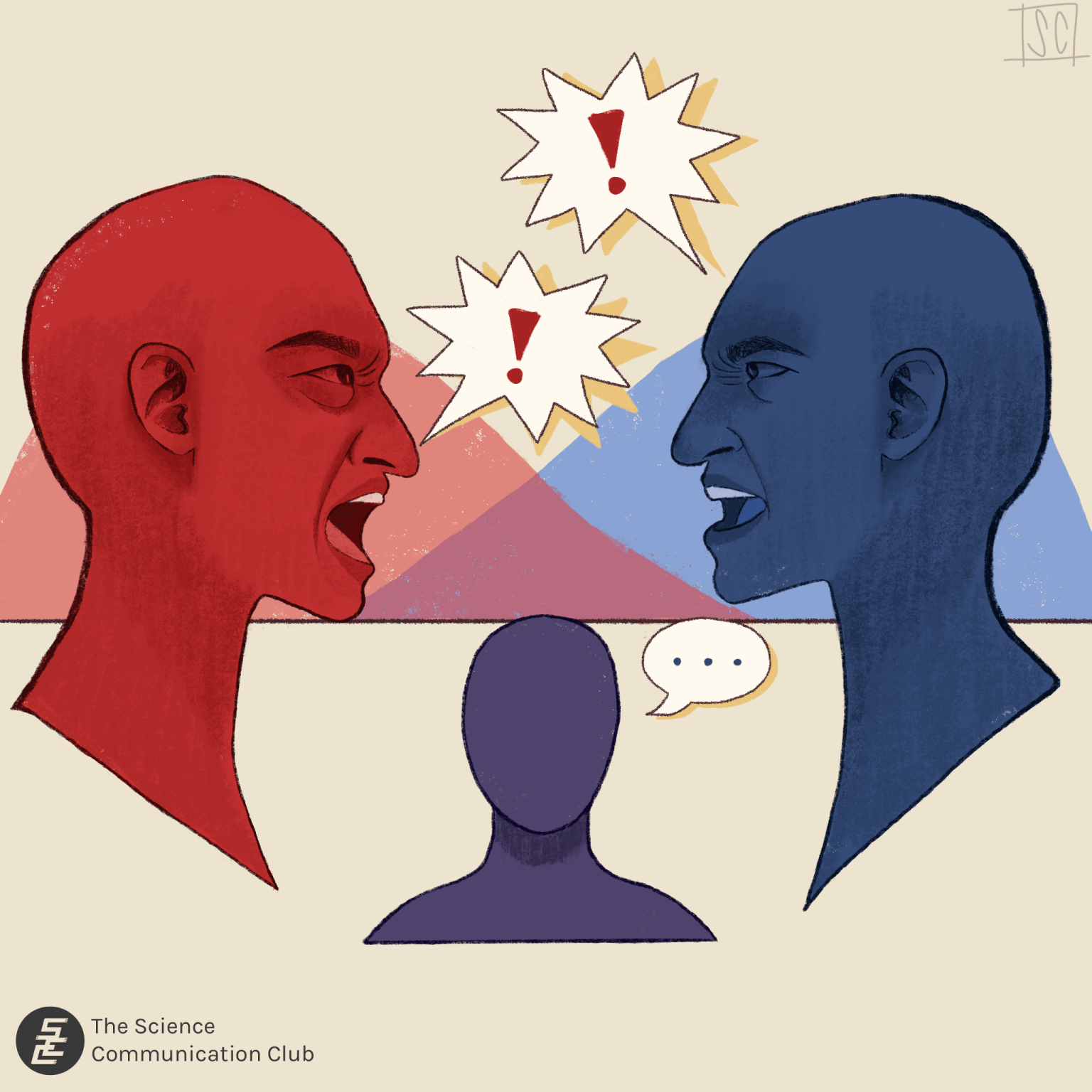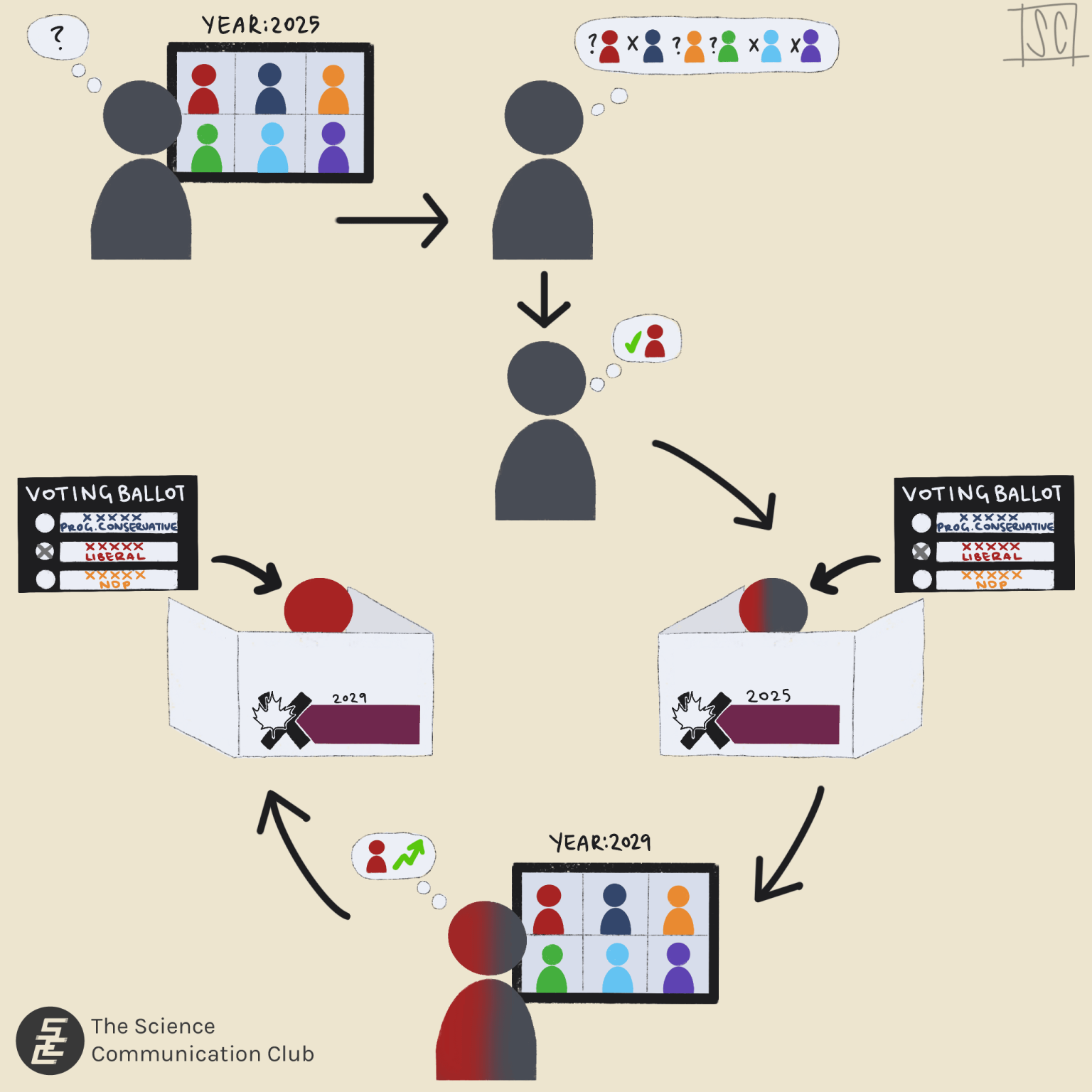
Written by Parmin Sedigh
Illustrated by Sabrina Chen
In romance novels, opposites supposedly attract. The polar opposite is true in politics. Disagreements are a fundamental part of politics, but the existence of some common ground between people with differing opinions should be as well. Yet we’ve all heard anecdotes of increasing polarization, especially online. And in many people’s eyes, the pandemic particularly highlighted our growing differences. So, it’s time to take a moment and analyze, scientifically, why we should care about polarization and why it may be happening.
First, it’s worth asking whether the tales of increasing polarization are indeed true. It turns out the literature on polarization is somewhat unclear, particularly in the US. Some papers claim polarization among ordinary people is deepening while others say that’s not true; some say polarization is a problem for society while others say it’s not or that its impact is unclear (1). We often think of science as the provider of the sole, correct conclusion, but there doesn’t seem to be a clear-cut answer here. Nonetheless, here’s what we do know.
The US Congress, for instance, has almost certainly become more polarized (2). Thankfully, the narrative is quite different for ordinary Canadians. Some believe our Southern neighbour has poisoned Canadian politics and given way to more extremism in Canada, or as sociologists Rachel McLay and Howard Ramos put so eloquently, “There is a persistent fear that, if the U.S. sneezes, Canada will catch a cold (3).” However, it seems we have a powerful immune system, because research suggests that polarization in Canada is much less pronounced, at least in the Atlantic provinces (3). This is likely in part due to the greater number of political parties in Canada, a factor that’s been suggested to help with increasing the diversity of thought in a country (4).
While Atlantic Canadians’ views were found to be moderate and normally distributed (with a slight left lean), a substantial portion of survey respondents in the study were concerned about polarization: 15% of respondents mentioned polarization or increasingly entrenched views as a major change they noticed over the past five years in Canada (3). Additionally, many participants blamed social media for negative changes they recently noticed in politics (3).

Even if the level of polarization in Canada is currently low, it doesn’t mean we shouldn’t be vigilant. Democracy relies on the diversity of ideas and interests, and when these ideas become flattened and all nuance is lost, democracy fails to function well (4). But if the flattening of ideas is so detrimental, why has it occurred in the first place? To understand this, we turn to a scientific method we may overlook in the study of political polarization, but one that is growing in importance: mathematical modelling (5) . Modelling involves taking abstract concepts and distilling them to their most essential components using mathematical equations. These models are particularly useful as they help explain complex real-world phenomena using relatively simple parameters and allow for lots of tinkering with variables6. Researchers can, for instance, create a model where people’s interactions with one another are influenced by whether the other person has similar views. They can then tune the model to different “settings”—like adjusting whether a society is already polarized or not—and tease out how a change in each setting affects the final outcome. Models can never capture all of the factors we see in the real world, but they have still offered new and fascinating insights into polarization.
For example, modelling has found that the disappearance of nuance in politics could be because people who’ve simplified their interests to be completely aligned with one political party or another can easily agree on topics and get things done (4). In other words, why bother with nuance when having the exact same ideas makes it easier to get bills passed?
A different mathematical model identified another process by which polarization can occur. The lynchpin of the study was that the preferences of voters aren’t fixed. In reality, our decisions and preferences work in a causal loop (2). This means that when we vote for a candidate, we “update [our] preferences such that [we like] that candidate a little more,” write political economists Steven Callander and Juan Carlos Carbajal (2). And now we like the candidate more and our preference has changed so in the future, we vote for them again and like them even more. On and on we go.
As mentioned earlier, many believe social media is to blame for polarization. Yet the evidence on this is inconclusive. Research has found that in the US, age groups that are less likely to use the internet and social media were more polarized (7), and another paper found polarization occurred on some social media platforms but not others (8). But this doesn’t mean we shouldn’t be careful about social media, not by a long shot. Most platforms still incentivize divisive content. For instance, when a news account or congressperson tweeted or posted on Facebook about someone from outside of their political party, they received twice as much engagement. In fact, the level of engagement increased the more they referred to the other party in their post (9).
Science is supposed to help us make better sense of the world. But all the science we’ve discussed so far only makes the future seem dim. However, science—and specifically models—can also provide us with solutions. A mathematical model of polarization based on both political groups and identity groups (groups based on characteristics like ethnicity or religion) found that economic redistribution could significantly reduce polarization (10). It seems that inequality plays a critical role in inducing polarization, and that reducing this inequality can be incredibly helpful in improving the problem. Another important finding was that societies that are already highly polarized need some sort of shock to the system, or a sudden change in how members of society interact with each other, to change the status quo of high polarization.
Ultimately, we need to accept that opposites will likely never attract in politics. But they don’t have to repel so strongly either.
Sources:
- Jost JT, Baldassarri DS, Druckman JN. Cognitive–motivational mechanisms of political polarization in social-communicative contexts. Nat Rev Psychol. 2022 [accessed 2023 Oct 27];1. doi: 10.1038/s44159-022-00093-5
- Callander S, Carbajal JC. Cause and Effect in Political Polarization: A Dynamic Analysis. J Pol Econ. 2022 [accessed 2023 Oct 27];Vol.130(4). doi: 10.1086/718200
- McLay R, Ramos H. Do Polarization Narratives Apply to Politics on the Periphery? The Case of Atlantic Canada. Front Sociol. 2021 [accessed 2023 Oct 27];Vol.6. doi: 10.3389/fsoc.2021.655880
- Bednar J. Polarization, diversity, and democratic robustness. Proc Natl Acad Sci. 2021 [accessed 2023 Oct 27];Vol.118(50). doi: 10.1073/pnas.2113843118
- Wang SS-H, Cervas J, Grofman B, Lipsitz K. A systems framework for remedying dysfunction in US democracy. Proc Natl Acad Sci. 2021 [accessed 2023 Oct 27];Vol.118(50). doi: 10.1073/pnas.2102154118
- Waldrop MM. Modeling the power of polarization. Proc Natl Acad Sci. 2021 [accessed 2023 Nov 5];Vol.118(37). doi: 10.1073/pnas.2114484118
- Boxell L, Gentzkow M, Shapiro JM. Greater Internet use is not associated with faster growth in political polarization among US demographic groups. Proc Natl Acad Sci. 2021 [accessed 2023 Oct 27];Vol.114(40). doi: 10.1073/pnas.1706588114
- Baden C, Kligler-Vilenchik N. Political Polarization on the Digital Sphere: A Cross-platform, Over-time Analysis of Interactional, Positional, and Affective Polarization on Social Media. Polit Commun. 2021 [accessed 2023 Oct 27];Vol.38. doi: 10.1080/10584609.2020.1785067
- Rathje S, Van Bavel JJ, van der Linden S. Out-group animosity drives engagement on social media. Proc Natl Acad Sci. 2021 [accessed 2023 Oct 27];Vol.118(26). doi: 10.1073/pnas.2024292118
- Stewart AJ, Plotkin JB, McCarty N. Inequality, identity, and partisanship: How redistribution can stem the tide of mass polarization. Proc Natl Acad Sci. 2021 [accessed 2023 Oct 27];Vol.118(50). doi: 10.1073/pnas.2102140118